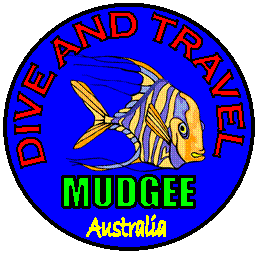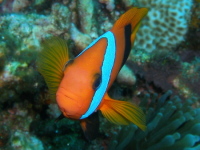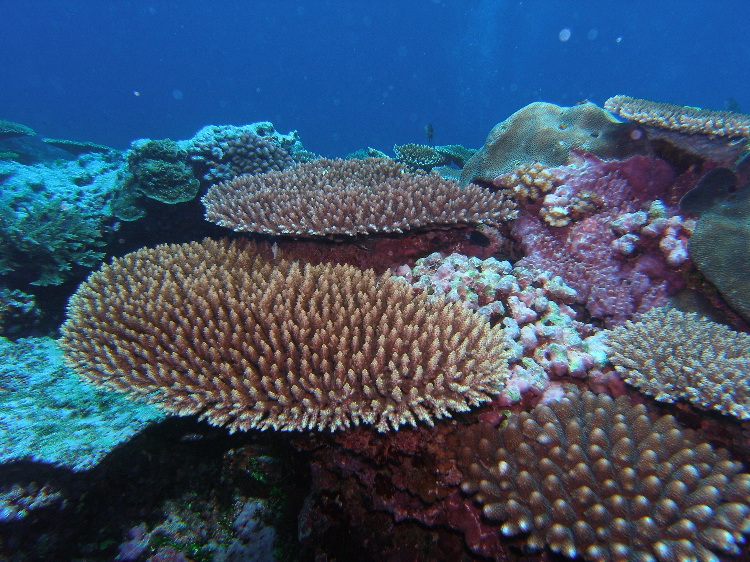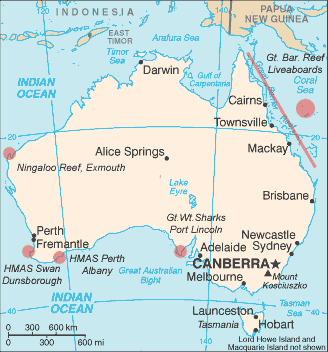
|
|
|
 |
||||||||||||||||||||||||||||||||||||
|
|
||||||||||||||||||||||||||||||||||||||

SCUBA DIVING IN Over 35,000km's of magnificent coastline gives Australia an incredible range of diving locations, including superb diving in the tropical waters of the world renowned Great Barrier Reef and northern parts of Western Australia, as well as fantastic temperate diving across the southern states of Australia. The Adventurers and thrill-seekers will love cage-diving with Great White Sharks, up close in their natural environment. Their size and power will awe divers who are able to get within centimetres of these creatures, thanks to an enclosing steel cage. Ningaloo Reef and Like Bicheno on the north-east coast of Tasmania is classified as one of the best temperate marine dive locations in the world. Famous for the underwater variety and colour. Visibility is typically 15 to 30m. Giant sea whips, sea horses, colourful sponges, zoanthids, large volumes of fish and migrating whales are just a taster of what this part of Australia has to offer. Antarctica remains the last vast wilderness on earth. A continent
encircled by pack ice, huge tabular icebergs and covered with an ice sheet
miles deep. A beautiful mysterious place, enticing explorers, adventurers
and dreamers over the decades. Remote, inhospitable and without permanent
inhabitants. It is the windiest and highest continent, which is capped by
an ice sheet over 4 km thick in places. Antarctica is 58 times larger than
the United Kingdom, and surrounded in winter by a vast
girdle of sea ice larger in area than the continent itself. For many, perhaps, the most appealing aspect of Antarctica is its wildlife. Although there are only a few native species, those that have adapted to the harsh environment thrive in large numbers. Seals, whales and Penguin populations are counted in the tens of thousands in some rookeries. One of the characteristics of the south polar region is that its birds and mammals (such as seals and whales) depend on the sea. In the end, the penguins evolved to a swimming way of living and because they had no land-predators to fear, they lost their ability to fly. Antarctica is so vast that only a small portion of it can be explored during a two week period. The Antarctic Peninsula, that part of the continent that points toward the tip of South America, is so long that it spans 12 degrees of latitude, approximately 1200 km or 800 miles. Humans never inhabited Antarctica and exploration of the continent is relatively recent. New discoveries continue to be made. In 2007, for example, our vessels, while exploring the Antarctic Peninsula, sailed uncharted waters. Antarctica is devoid of power lines, billboards, and highways. There are no designer coffee shops or cellular networks. When the engines are turned off, the only sounds you hear are natural - wildlife, water and the occasional boom of icebergs calving. If you listen closely, you can hear your heart beating with excitement!
Lord Howe Island celebrated its 25th anniversary of World Heritage listing in December, 2007. It is one of only a handful of island groups on the UNESCO World Heritage list, inscribed for its biodiversity and spectacular landscape and is home to hundreds of beautiful and rare plants, birds and marine species. The island was created by a volcanic eruption seven million years ago. It boasts a number of unique natural experiences including diving the world’s southernmost coral reef and visiting Balls Pyramid – the tallest sea stack in world. Two-thirds of the island is covered in natural forests, Banyan trees and Kentia palms. Lord Howe Island is situated 550 kilometres east of Port Macquarie, New South Wales, Australia and less than two hours from Sydney, Brisbane and Port Macquarie airports. The Island is 11 kilometres long and less than three kilometres at its widest point. Island population: A paradise where only 400 visitors are allowed on the island at any one time and there are only 350 residents. Cocos/Keeling and Christmas Island:
|
|
|
|
|
MUDGEE DIVE & TRAVEL: THE PREMIER CHOICE FOR DISCERNING DIVERS AND TRAVELERS.
Site Design: Grant Willetts (MD&T)
Ph: 02 6372 1023; M: 0421 277 300; International: 61 2 6372 1023 ABN 98 124 932 154
All images, logos and trademarks are copyright of their respective owners. © Copyright 2005-2014. All Rights Reserved
Disclaimer: Data and information is provided for informational purposes only, and is not intended for any other commercial or non-commercial purposes. Neither us nor any of our data or content providers shall be liable for any errors or delays in the content, or for any actions taken in reliance thereon. By accessing our web site, a user agrees not to redistribute the information found therein. We provide customized links to select companies for your convenience only. We do not endorse or recommend the services of any company. The company you select is solely responsible for its services to you, the user. We shall not be liable for any damages or costs of any type arising out of or in any way connected with your use of our services.
| Site Map |



